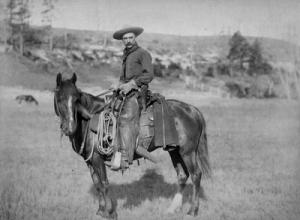BiometricsSenior Russian security officials exhibit “gunslinger gait”: Experts
Experts have discovered a new gait pattern among several top Russian officials, including President Vladimir Putin and Prime Minister Dmitry Medvedev. The researchers term this “gunslinger’s gait” because it may be triggered by KGB or other forms of weaponry training. The gait features a consistently reduced right-sided arm swing, highlighted in video material of the individuals studied.

Gunslinger from 1888 // Source: wikipedia.org
Experts have discovered a new gait pattern among several top Russian officials, including President Vladimir Putin and Prime Minister Dmitry Medvedev. The researchers term this “gunslinger’s gait” because it may be triggered by KGB or other forms of weaponry training.
The gait features a consistently reduced right-sided arm swing, highlighted in video material that accompanies the paper (see links below).
Writing in the Christmas issue of The BMJ, the researchers say this distinct walk could be mistaken for early Parkinson’s disease and they advise doctors to keep this in mind when assessing patients.
BMJ reports that movement disorders enthusiasts Professor Bas Bloem and colleagues often scrutinize the way people walk — and noticed several YouTube videos of Russia’s president Vladimir Putin, showing a clearly reduced right-sided arm swing on a series of different occasions.
Reduced arm swing can be a sign of early Parkinson’s disease, raising the question whether Putin — and the other Russian top officials — might all be in an early phase of this disease too.
Searching for other possible explanations, the researchers encountered a training manual of the former Russian KGB, giving the following instruction on how operatives should move in the field: “When moving, it is absolutely necessary to keep your weapon against the chest or in the right hand. Moving forward should be done with one side, usually the left, turned somewhat in the direction of movement.”
The researchers wondered whether this could explain Putin’s gait, since he had received KGB training earlier in life.
If this were true, then it would be reasonable to expect a similar gait “abnormality” in other Russian officials who might have received similar instructions during weaponry training by the KGB or by other military or intelligence agencies.
The researchers searched YouTube for videos of other Russian officials, with surprising results.
An asymmetrically reduced arm swing was identified in several highly ranked Russian officials, including not only Putin, but also Prime Minister Dmitry Medvedev, two former ministers of defense (Anatoly Serdyukov, and Sergei Ivanov), and Anatoly Sidorov, a senior military commander.
Rather than interpreting this gait pattern as being pathological, “we feel that there is another - and perhaps more plausible — explanation, namely a behavioral adaptation resulting from military or intelligence training,” write the authors.
BMJ notes that they found other examples of a reduced arm swing related to weaponry training. For example, cowboys of the Wild West, depicted in movies, also frequently have a reduced arm swing.
“We propose that this new gait pattern, which we term ‘gunslinger’s gait,’ may result from a behavioral adaptation, possibly triggered by KGB or other forms of weaponry training where trainees are taught to keep their right hand close to the chest while walking, allowing them to quickly draw a gun when faced with a foe,” they explain.
“This should be included in the differential diagnosis of a unilaterally reduced arm swing,” they conclude.
— Videos: President Vladimir Putin; Prime Minister Dmitry Medvedev; Anatoly Serdyukov (minister of defense 2007-12); Sergei Ivanov (minister of defense 2001-07, present chief of the presidential administration of Russia); Anatoly Sidorov (current commander of the Western Military District)
— Read more in Rui Araújo et al., “Gunslinger’s gait”: a new cause of unilaterally reduced arm swing,” British Medical Journal (BMJ) (14 December 2015): 351 (doi: http://dx.doi.org/10.1136/bmj.h6141)
